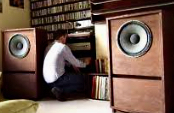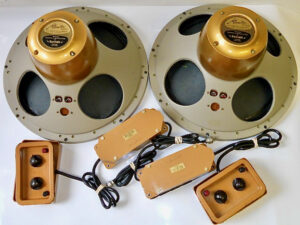
They were bought from London. And the first owner bought them in Lancaster enclosures. The gentleman used them in his private recording studio for a few years during the 70s. And later, the drivers were removed from enclosures to upgrade. But it never happened, and for 30 years, these drivers were waiting for me in storage.
Tannoy Monitor Gold 15″
When I first plugged these drivers into hardly-optimized test cabinets, I was impressed with their sound. And this was using crossovers with old electrolytic capacitors. After many hours of soldering and even more woodworking, I tested these drivers with crossovers based on excellent quality components. And in heavy, sand-filled, 25mm thick plywood bass reflex enclosures.
As you have gathered, I bought these drivers without any enclosures, so I could not review any particular model of vintage Tannoy speakers. And, from what I have heard, Tannoy enclosures from the basic range are flexible and people who buy them sooner or later replace them with better-quality DIY cabinets. Having listened to Tannoy Monitor Gold drivers in many different enclosures, I am confident that the enclosures used for this review allowed the drivers to show their character and essential sound qualities. Tannoy Monitor Gold 15″
Speaker Info

And itself would not be so unique as there are many other coaxial drivers; however, in Tannoys, the tweeter diaphragm is placed behind the bass driver’s magnet, and the same magnet used to power both. Furthermore, the tweeter diaphragm positioned in an inverted phase. The airwaves it produces travel through the ‘Pepper Pot’ phase plug. Then, they are ‘acoustically amplified’ in the metal horn throat (inside the magnet) and ‘amplified’ further by the bass diaphragm. However, several HiFi manufacturers use horns with excellent results (e.g. Klipsch, JBL, Altec, Lowther), and Tannoy is one of them.
Description
And a rather basic description, but it gives a good overview of how these drivers work. People who are into DIY may find it strange that a heavy paper cone (LF unit) is crossing over with the efficient HF unit at 1kHz as this contradicts best practices found in many speaker-building books. But it works. And it works rather well! Having two diaphragms on one axis (in theory) should result in better pin-point imaging than in traditional speaker designs. The whole frequency range originates at one point source of the sound instead of two or three different drivers placed somewhere on the speaker’s face. Tannoy Monitor Gold 15″
The Tannoy Monitor Gold range was trendy in recording studios in the 1970s. Many famous studios (including Abbey Road in London) used these speakers for mixing. And numerous legendary albums mixed using these speakers, so if you have a couple at home, you may hear the recording similar to the person who made it. Also, I have found something that indicates that some recording studios may have used these speakers in more modern times. Apart from studio monitoring, these drivers used in the domestic market’s higher end and used in large horn-loaded enclosures such as Tannoy GRF, Tannoy GRF Professional and Tannoy Autograph.
Monitor Gold 15 Specs
- Frequency Response: 23 – 20,000Hz
- Sensitivity: 92dB
- Impedance: 8Ω (5Ω min.)
- Power Capacity: 50W
High & Low-Frequency Driver: LSU/HF/15/8 380mm (15″) Dual Concentric with 51mm (2″) Aluminium Dome Compression Driver and 380mm (15″) Paper Diaphragm
- Crossover Frequencies: 1,000Hz
- Free Air Resonance (FS): 26Hz
- Weight: 10kg (each driver)
- Production Year: 1968
- Price When Launched: £84 for a pair
- Equivalent Present-Day Price: £1,380 for a pair
- Current UK Price: £1,300 to £1800 for a pair
Look & Feel
Forty-six years after they were made, these drivers still look very impressive. The baskets are made from a very rigid die-cast alloy and are stove enamelled—bass diaphragms made from paper. The diaphragm suspension extends the actual diaphragm and coated with a rubbery-looking substance. And the motors are rather large alnico magnets hidden under gold plastic covers. The crossovers are nicely soldered, using components available when these were made. Wires, sockets and plugs are relatively low quality by modern standards. However, they were probably OK back in the day. Overall, despite the pitfalls, they are impressive drivers. And Playing with these drivers was like an old Jaguar E Type – a classic beauty. Tannoy Monitor Gold 15″
Monitor Gold 15″ sound
When connected to these relatively large loudspeakers for the first time, they were very overwhelming, in a good way, though. The presentation of the sound is very different from the traditional speaker constructions. The first thing that I noticed was the soundstage. It was like a massive wall of sound. The soundstage was still there, and I could separate the instruments, etc., but the sound was never coming from behind the speakers, so there was little soundstage depth.
The Tannoy Monitor Gold drivers are high-speed and dynamic, and compared to many modern speakers, this can be very nice. Feeling the physical impact of the sound is not something that people are used to these days, especially people who use stand-mount monitors for playback. Bass is never floppy or boomy and always stays under control. And it goes deep. You can hear the sound even at 35Hz. Midrange and treble sound very sweet and easy to listen to. However, the MG15s are only some of the most detailed speakers in the world.
Detail
More detailed loudspeakers provide better separation, but only a few speakers deliver the full-bodied sweet sound these Tannoy Monitor Gold do. What they do best are saxophones, double bass and vocals – I have never heard My Romance by Ben Webster sounding so realistic on any other speakers or Temptation by Diana Krall sounding so right. These speakers struggle when the depth of the soundstage and separation plays a vital role in the perception of the song – try Needed Time by Eric Bibb or Auberge by Chris Rea to see what I mean.
Don’t get me wrong; they will still sound reasonably detailed and easy to listen to. However, they are other speakers within this price range that can deliver much deeper soundstage imaging and give you an overall better experience. They are also not the most truthful presenters – there is a degree of sound colouration. But don’t be put off by this, as this is part of their character and what makes them Monitor Golds. To me, enjoyment and engagement are the most critical factor when listening, and these drivers can certainly deliver both.
Regarding amplification, many people (probably due to the relatively high sensitivity of these drivers) suggest using them with valve amps. I have read that these drivers are designed with transistor amps in mind, hence their 8-ohm nominal impedance. I’ve tried them with both valve and transistor amps, and I prefer their sound with a suitable transistor, mainly due to better dynamics and bass control. Tannoy Monitor Gold 15″
Conclusion
Tannoy Monitor Gold drivers are very musical and easy to listen to. No, the most detailed, and the soundstage depth could be better, but despite these pitfalls, very enjoyable to hear. Overall, it was a sweet sound with a lot of kick and energy. If you have enjoyed this ‘Tannoy Monitor Gold 15″, please share with friends
Author: Audio Nostalgia,UK
Reviewed: October 2014 | Published: November 2014
Perkune I Best Professional service